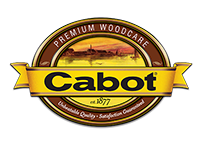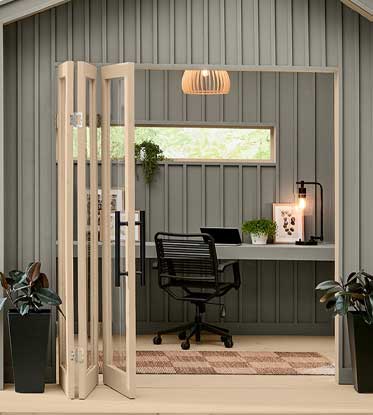
Get the Look: How to Create an Outdoor Workspace
Tools and tips for transforming your outdoor living space into a usable workspace
With the continued shift from traditional in-office jobs to remote, work-from-anywhere opportunities, homeowners are not only spending more time at home, they are also dedicating more time to DIY projects while there. With a focus on integrating their indoor and outdoor spaces, yards, patios and gardens have become extensions of inside living spaces, just as reflective of unique personal styles and used for many of the same purposes—relaxing, dining, entertaining and even joining conference calls.
Without a doubt, outdoor offices and work areas are the perfect way to make the most of your living space.
From outdoor desks, cafés and full-blown offices masquerading as run-of-the-mill storage sheds, transforming your outside space—no matter the size—is simpler than you might think. With some time, inspiration and a little help from the experts at Cabot®, the possibilities for designing and building your dream outdoor living (or working) space are endless.
- Creating Your Outdoor Workspace
- Tools & Materials
- Preparation & Staining
Imagining what your outdoor office space could be is one thing; building a beautiful outdoor office with wood and staining it on your own is another. Using wood stain for the project allows for the wood’s natural beauty and wood grain to show through.
Before getting started, it’s important to know where you want to end up. Building an outdoor office best suited to your needs and personality, as well as most fitting for your budget and the space you’re looking to beautify, is the first step.
Build an Outdoor Workspace: Desk
Practical, functional and made to help you get things done, whether for your regular 9-to-5 or fair-weather chores around your home’s exterior.
Build an Outdoor Workspace: Café
An outdoor café provides ample seating and plenty of room to spread out with work, food, friends or whatever else suits you.
Build an Outdoor Workspace: Shed
The one-room shed walls your outdoor workspace in to provide more of a traditional at-home office feel, but with the option to let in as much air or natural light as you’d like.
Tip: When building an outdoor office shed, the roof is perhaps the most important piece. A shed or wedge-shaped roof is recommended to a flat one in this case, as a larger slope helps direct rainwater, other moisture and debris away from the sides and foundation of your building, where it could cause potential problems.
So, now that you have a DIY outdoor office project in mind, what’s next?
Think Tools First
To create your outdoor wood furniture, it’s important to use the right tools for the job. This means having your scraper, applicators, trays, cleaners and other products on hand to properly prep, stain and protect your DIY project.
Here are the items we suggest:
- Scraper or wire brush
- Sandpaper
- Paint tray with liner
- Premium stain applicator, like a Purdy® brush or roller
- Cabot® Wood Stain Pad Applicator
- Stain of your choice
- Brush comb or cleaning tool
Selecting the Right Materials
You also need to define the look you’re after when the work is done. The type of wood you select for building an outdoor office should be one you love for its looks, as well as its ability to withstand the elements and deliver years of use.
Select wood that is dense and sturdy. Think hardwoods. Teak and ipé are often used to create outdoor furniture, and for good reason. Both are very durable and just as resistant to rot, warping and cracking, lending them to long lives spent in the great outdoors. Better yet, they’re also known for being low-maintenance woods over time, so the time and energy demanded from you each summer for upkeep will be minimal. Acacia, black locust and cypress are other good options.
Pine and cedar are also good options, as they’re less dense and can be a bit easier to work with than teak and ipé . These woods also tend to be more affordable and readily available options, commonly found at most home centers. Plus, cedar, which has a beautiful grain, also provides natural bug repellency, a bonus for any project.
Tip: White oak is another species of wood that’s just as durable, yet much easier to work with. While it does require a bit more maintenance than ipé and teak, it is rot-resistant and much more abundant than both as well.
Hardwoods versus softwoods. It’s all about stability—and maintenance—over the long term. After years of exposure to moisture, UV rays and use by rough-and-tumble youngsters, softer wood, such as cedar, may begin to warp or change in shape and dimension. Harder wood species, like teak, are not only more resistant to those kinds of physical changes thanks to their densities, but also withstand exposure to the elements for decades with little more than a protective clear coat. If you have questions about the type of wood that’s best for your outdoor workspace project, ask! Your local lumberyard or home center is full of experts who are willing to guide you.
Natural oils and water-repellency. A wood’s natural oil content contributes to its ability to repel water and resist both rot and insect invasion. The higher the oil content, the more resistant the finished product should be, for a given period, to moisture and other elements. Acacia is a prime example of a wood with a high oil content that’s fast-growing and widely available, making it far more affordable as well.
Keep in mind the wood’s appearance. It’s important you love how your DIY outdoor office furniture piece looks and that the final product fits with the vibe you’ve created inside and outside your home. Wood grains vary in texture, shape and color, with some being more ornate and decorative than others. Whether straight, wavy, spiral, irregular, tiger stripe and more, bold wood grain patterns are a bonus when it comes to complementing the overall ambiance of your outdoor living space. Cypress, ipé and teak often have wide, variable grains that add a touch of excitement, while oak and cedar tend to have straighter, less intricate grain patterns.
Consider other construction materials. There’s more to your build than wood, which means there are a few more items to consider. For example, how will your desk be held together—screws or glue? What kind of screws? And how do you know? For starters, yes. Both glue and screws are the right answer here.
As for the type of screws, since your outdoor office will be just that, outdoors, you must take exposure to the elements into consideration prior to your build. Black-oxide screws tend to rust. Zinc-coated screws are only mildly resistant to corrosion and wear from moisture. Your best bet? Stainless steel or brass screws (or those coated with either). They’re more resistant to rust and are what professional deck builders and other contractors lean toward.
Using glue and screws together, however, adds an additional layer of security when it comes to holding your wood pieces together. This approach also helps prevent screws from popping out of place and boards sliding, shifting or moving out of the desired position. In general, exterior wood glues are a good addition to your DIY project, as they provide even more stability.
Prep Wood for Outdoor Use
All surfaces, indoors and out, pick up dirt, dust and other contaminants as they come into contact with the elements and pollution, are transported and touched by people or animals. Since those contaminants can significantly impact the quality of the finish of the wood, they should be removed before staining.
If paint was previously applied to the item you’ll be transforming into an outdoor desk, café or other workspace, it will need to be removed with a paint and stain stripper and scraper or wire brush prior to staining. In addition, since moisture can cause issues when paint or stain is applied, make sure the wood is dry before getting started. Other integrity issues, such as rotting or decaying areas, should be addressed and replaced ahead of staining.
Need more guidance when it comes to selecting the most appropriate exterior wood stain for the surface you’re working with? Cabot’s Project Helper will steer you in the right direction.
Staining Exterior Wood Surfaces
Our wood preparation and professional-quality exterior wood stains deliver rich, beautiful color, highlight the true character of the wood and provide a protective layer that withstands the worst Mother Nature can dish out. After determining the balance of color and protection that’s right for you, known also as opacity, you’re ready for the fun part of the outdoor office creation process—choosing your exterior wood stain and starting the staining process.
Cabot® brand outdoor wood stains are available in 100 nature-inspired color options and varying transparencies, including:
- Wood-toned and clear stain
- Semi-transparent stain
- Semi-solid stain
- Solid stain
- DeckCorrect™
Another coating option, Cabot® Australian Timber Oil, is made using the purest, highest-quality linseed oil, tung oil and long-oil alkyds available and augmented with trans-oxide pigments to keep your project protected from UV rays, accentuate the texture and grain of the wood, repel moisture and prevent peeling and flaking. Also available as an aerosol, this translucent oil treatment protects exterior wood surfaces from extreme conditions without sacrificing any of the beauty delivered by the natural grain.
Sealers and waterproofers can also be added to your outdoor office workspace and surrounding surfaces, including wood, concrete and brick, to seal porous surfaces for lasting resiliency against water, mildew and algae.
Tip: Who doesn’t love the finishing touches? When it comes to the interior of your outdoor workspace, even if it’s an open-air café style, get creative by adding paint, wallpaper, tile, carpet, real or engineered wood and any other accents that will make the space conducive to productivity and fist pumps.
With these tools and tips, you’ll have no trouble transforming your yard, patio, garden or other outside area into a whole new place.
